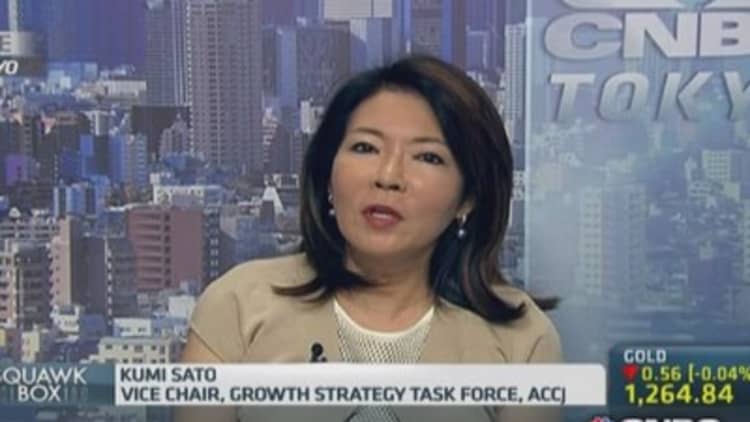Japanese Prime Minister Shinzo Abe's campaign to empower women, dubbed 'womenomics', aims to boost the economy by increasing female labor force participation and to offset a rapidly ageing population, but a shortage of nurseries continues to undermine his effort.
"This is a real crisis. The birth rate has been so low for decades that the population is set to decrease by a third in twenty years," said Kanako Amano, research fellow at the NLI Research Institute in Tokyo.
In the latest campaign manifesto, Shinzo Abe stuck to last year's pledge to create over 400,000 nursery spots – the official estimate that includes demand not reflected in the waiting list – by 2017.
Read More The Abenomics death spiral
But experts say it's not clear where the money will come from. Last month, the government decided to delay a second consumption tax hike to 10 percent, initially scheduled for October 2015, by 18 months, after the first hike to 8 percent this April tipped the country into recession. The second hike was supposed to help pay for childcare reform.

"There is now a 700 billion yen ($5.9 billion) shortfall and it's not clear how it's going to be made up for," said Junko Takaoka, Research Manager at the Benesse Educational Research and Development Institute.
Three-pronged strategy
In addition to creating nursery spots, Abe aims to boost female labor force participation by easing qualification requirements for nursery teachers, increasing the number of state authorized "nursery moms" – stay-at-home mothers that baby sit for a fee – and extending partially paid maternity leave to three years from one year currently.
But analysts are skeptical.
"Japan already has an estimated 300,000 qualified nursery teachers who choose not to work in the field because of the poor pay and conditions," said Amano.
Furthermore, three years' maternity leave is long, demonstrating how out of sync Japan is compared with other developed countries, said Amano. Americans, by comparison, get 12 unpaid weeks maternity leave, while Norwegians get 40 weeks at near full pay, according to a 2012 Save the Children report.
Read More Risks to 'Abenomics' growing, whether Japan PM raises tax or not
"The company makes you feel like you don't belong to the workplace anymore after one year," says Eriko Suzuki, a mother of one who says she was targeted to be laid off after returning from her year-long maternity leave. "You would definitely feel you have no position left after three years", she added.
Furthermore, nursery moms don't need formal qualifications, just a permit from the local authority, according to Benesse's Takaoka. Authorizing more "nursery moms" probably won't change much because most parents prefer leaving their children with qualified staff.
Dual income required
Japan is ageing more rapidly than any other developed country, according to a 2013 United Nations report. The birthrate has been below has been what's needed to maintain current population levels for nearly four decades, a that trend appears unlikely to change given the high cost of raising children.
"You can't raise a family on just one income anymore," said Benesse's Takaoka.
In the government's latest survey, over 80 percent of respondents under the age of 30 cited the cost of childrearing as the main reason they won't have as many kids as they would like, a white paper on tackling the declining birth rate published this week showed.

Mothers with young children may need to work to help pay for childrearing costs, but currently more than a third (36 percent) give up paid employment when they have their first child, according to a government survey. They do go back to work, but around 60 percent of them only work part time, according to Benesse's Takaoka.
Getting back into the workforce is tough: of the mothers that leave the work force for a few years to raise children and then sign up at the 160 employment centers set up specifically for them, only a third find jobs.
Hidebound work culture
Long working hours are another obstacle for parents. While people in Japan work an average 1,745 hours a year – near the Organization for Economic Co-operation and Development (OECD) average of 1,765 hours – working arrangements tend to be inflexible.
Read More Japan snap election: a sign Abenomics is crumbling?
Reforming work practices for both working mothers and fathers may be in order, according to Masaki Miyaguchi, an official at the Ministry of Health, Labor and Welfare's Employment Security Bureau. "Companies need to be more understanding about a working mother's time constraints," he added.
"It's almost impossible to stay in full time work if you don't have the ultimately traditional family safety net – grandparents who live close by enough to take care of the kids at short notice," said Suzuki, who is now self-employed.
"The burden is always on the mother to leave work and take care of the child. The attitude that the father should take time off just doesn't exist."

